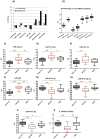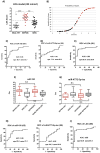Genome-wide sequencing of cellular microRNAs identifies a combinatorial expression signature diagnostic of sepsis
- PMID: 24146790
- PMCID: PMC3797812
- DOI: 10.1371/journal.pone.0075918
Genome-wide sequencing of cellular microRNAs identifies a combinatorial expression signature diagnostic of sepsis
Abstract
Rationale: Sepsis is a common cause of death in the intensive care unit with mortality up to 70% when accompanied by multiple organ dysfunction. Rapid diagnosis and the institution of appropriate antibiotic therapy and pressor support are therefore critical for survival. MicroRNAs are small non-coding RNAs that play an important role in the regulation of numerous cellular processes, including inflammation and immunity.
Objectives: We hypothesized changes in expression of microRNAs during sepsis may be of diagnostic value in the intensive care unit (ICU).
Methods: Massively parallel sequencing of microRNAs was utilised for screening microRNA candidates. Putative microRNAs were validated using quantitative real-time PCR (qRT-PCR). This study includes data from both a training cohort (UK) and an independent validation cohort (Sweden). A linear discriminant statistical model was employed to construct a diagnostic microRNA signature.
Results: A panel of known and novel microRNAs were detectable in the blood of patients with sepsis. After qRT-PCR validation, microRNA miR-150 and miR-4772-5p-iso were able to discriminate between patients who have systemic inflammatory response syndrome and patients with sepsis. This finding was also validated in independent cohort with an average diagnostic accuracy of 86%. Fractionating the cellular components of blood reveals miR-4772-5p-iso is expressed differentially in monocytes. Functional experiments using primary human monocytes demonstrate that it expressed in response to TLR ligation.
Conclusions: Taken together, these data provide a novel microRNA signature of sepsis that should allow rapid point-of-care diagnostic assessment of patients on ICU and also provide greater insight into the pathobiology of this severe disease.
Conflict of interest statement
Figures




Similar articles
-
Circulating Plasma microRNAs can differentiate Human Sepsis and Systemic Inflammatory Response Syndrome (SIRS).Sci Rep. 2016 Jun 20;6:28006. doi: 10.1038/srep28006. Sci Rep. 2016. PMID: 27320175 Free PMC article.
-
Plasma microRNA Profiles as a Potential Biomarker in Differentiating Adult-Onset Still's Disease From Sepsis.Front Immunol. 2019 Jan 11;9:3099. doi: 10.3389/fimmu.2018.03099. eCollection 2018. Front Immunol. 2019. PMID: 30687316 Free PMC article.
-
Analysis of the diagnostic and prognostic value of Peripheral blood mononuclear cell microRNA-9-5p in patients with sepsis in the intensive care unit.Front Cell Infect Microbiol. 2025 Apr 22;15:1509496. doi: 10.3389/fcimb.2025.1509496. eCollection 2025. Front Cell Infect Microbiol. 2025. PMID: 40330014 Free PMC article.
-
Circulating MicroRNAs as Biomarkers for Sepsis.Int J Mol Sci. 2016 Jan 9;17(1):78. doi: 10.3390/ijms17010078. Int J Mol Sci. 2016. PMID: 26761003 Free PMC article. Review.
-
The Relationship between Extracellular/intracellular microRNAs and TLRs May Be Used as a Diagnostic and Therapeutic Approach in Sepsis.Immunol Invest. 2022 Jan;51(1):154-169. doi: 10.1080/08820139.2020.1817067. Epub 2020 Oct 15. Immunol Invest. 2022. PMID: 33054447 Review.
Cited by
-
Non-coding RNAs and Exosomes: Their Role in the Pathogenesis of Sepsis.Mol Ther Nucleic Acids. 2020 Sep 4;21:51-74. doi: 10.1016/j.omtn.2020.05.012. Epub 2020 May 15. Mol Ther Nucleic Acids. 2020. PMID: 32506014 Free PMC article. Review.
-
Exosomes Derived From Heat Stroke Cases Carry miRNAs Associated With Inflammation and Coagulation Cascade.Front Immunol. 2021 Jun 22;12:624753. doi: 10.3389/fimmu.2021.624753. eCollection 2021. Front Immunol. 2021. PMID: 34239515 Free PMC article.
-
Expression patterns and prognostic value of miR-210, miR-494, and miR-205 in middle-aged and old patients with sepsis-induced acute kidney injury.Bosn J Basic Med Sci. 2019 Aug 20;19(3):249-256. doi: 10.17305/bjbms.2019.4131. Bosn J Basic Med Sci. 2019. PMID: 30997877 Free PMC article.
-
Diagnostic accuracy of procalcitonin, neutrophil-lymphocyte count ratio, C-reactive protein, and lactate in patients with suspected bacterial sepsis.PLoS One. 2017 Jul 20;12(7):e0181704. doi: 10.1371/journal.pone.0181704. eCollection 2017. PLoS One. 2017. PMID: 28727802 Free PMC article.
-
Accuracy of circulating microRNAs in diagnosis of sepsis: a systematic review and meta-analysis.J Intensive Care. 2020 Nov 2;8(1):84. doi: 10.1186/s40560-020-00497-6. J Intensive Care. 2020. PMID: 33292630 Free PMC article. Review.
References
-
- Angus DC, Linde-Zwirble WT, Lidicker J, Clermont G, Carcillo J, et al. (2001) Epidemiology of severe sepsis in the United States: analysis of incidence, outcome, and associated costs of care. Crit Care Med 29: 1303–1310. - PubMed
-
- Dellinger RP, Carlet JM, Masur H, Gerlach H, Calandra T, et al. (2004) Surviving Sepsis Campaign guidelines for management of severe sepsis and septic shock. Crit Care Med 32: 858–873. - PubMed
-
- Gaieski DF, Pines JM, Band RA, Mikkelsen ME, Massone R, et al. (2009) Impact of time to antibiotics on survival in patients with severe sepsis or septic shock in whom early goal-directed therapy was initiated in the emergency department. Crit Care Med - PubMed
-
- Beale R, Reinhart K, Brunkhorst FM, Dobb G, Levy M, et al. (2009) Promoting Global Research Excellence in Severe Sepsis (PROGRESS): lessons from an international sepsis registry. Infection 37: 222–232. - PubMed
Publication types
MeSH terms
Substances
Grants and funding
LinkOut - more resources
Full Text Sources
Other Literature Sources
Medical

